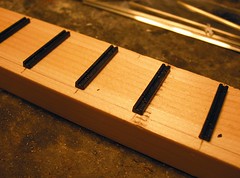 First up - fix the sleepers to the baseboard. In the instructions, Sundeala is recommended as it will accept pushing in the spikes that hold the rail down easily and without recourse to a hammer. I'm not building a layout, just a test track, so a piece of pine was chopped to length. It's a little harder than Sundeala but more likely to remain flat over time. Anyway, I didn't have anything else to hand.
First up - fix the sleepers to the baseboard. In the instructions, Sundeala is recommended as it will accept pushing in the spikes that hold the rail down easily and without recourse to a hammer. I'm not building a layout, just a test track, so a piece of pine was chopped to length. It's a little harder than Sundeala but more likely to remain flat over time. Anyway, I didn't have anything else to hand.The sleepers are very nice mouldings of Hudson pattern cast iron prototypes. KB Scale specialise in industrial railways and those lines were often laid and re-laid as the construction project or mine workings required. Temporary railway lines are something we rarely see nowadays (the channel tunnel was the last one I know of, but please feel free to correct me) and the cast iron sleeper was more robust than its wooden counterpart and therefore better suited to this use and abuse.
Yet again, I ignored the instructions when they suggested using plastic solvent to fix the sleepers to the "board". I prefer double sided sticky tape for this job. OK, the track isn't going to be lifted in the same way as you do when building PCB track - the spikes mean once laid it will be firmly nailed to the baseboard !
Sleeper spacing is suggested in the instructions. The kit allows two track panels to be made up and ensures you get something prototypical. I held the plan against my bit of wood and marked the centres in pencil then put the tape down and finally the sleepers. If the spacing is a bit off, well I don't suppose the real thing was perfect.
1 comment:
I think the "jubilee" track actually had pressed steel sleepers rather than cast, to which the rails were bolted. This made it cheap, rigid, and lightweight, ideal for temporary lines. It was essentially 2' gauge set-track!
I've always fancied a spot of O14, indusrial diesels, skips, and pre-fab track. Maybe one-day I'll get around to it!
Post a Comment